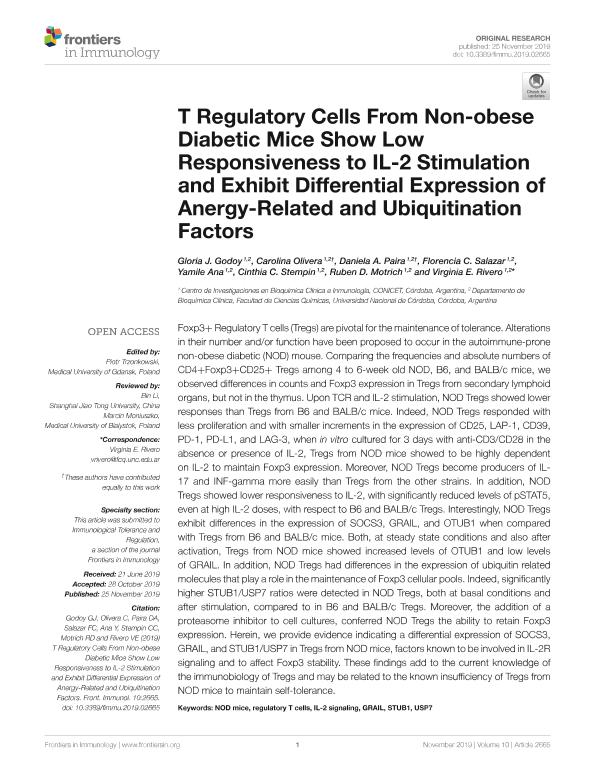Artículo
T Regulatory cells from non-obese diabetic mice show low responsiveness to IL-2 stimulation and exhibit differential expression of anergy-related and ubiquitination factors
Godoy, Gloria Janet ; Olivera, Carolina
; Olivera, Carolina ; Paira, Daniela Andrea
; Paira, Daniela Andrea ; Salazar, Florencia; Ana, Yamile
; Salazar, Florencia; Ana, Yamile ; Stempin, Cinthia
; Stempin, Cinthia ; Motrich, Ruben Dario
; Motrich, Ruben Dario ; Rivero, Virginia Elena
; Rivero, Virginia Elena
 ; Olivera, Carolina
; Olivera, Carolina ; Paira, Daniela Andrea
; Paira, Daniela Andrea ; Salazar, Florencia; Ana, Yamile
; Salazar, Florencia; Ana, Yamile ; Stempin, Cinthia
; Stempin, Cinthia ; Motrich, Ruben Dario
; Motrich, Ruben Dario ; Rivero, Virginia Elena
; Rivero, Virginia Elena
Fecha de publicación:
11/2019
Editorial:
Frontiers Media S.A.
Revista:
Frontiers in Immunology
e-ISSN:
1664-3224
Idioma:
Inglés
Tipo de recurso:
Artículo publicado
Clasificación temática:
Resumen
Foxp3+ Regulatory T cells (Tregs) are pivotal for the maintenance of tolerance. Alterations in their number and/or function have been proposed to occur in the autoimmune-prone non-obese diabetic (NOD) mouse. Comparing the frequencies and absolute numbers of CD4+Foxp3+CD25+ Tregs among 4 to 6-week old NOD, B6, and BALB/c mice, we observed differences in counts and Foxp3 expression in Tregs from secondary lymphoid organs, but not in the thymus. Upon TCR and IL-2 stimulation, NOD Tregs showed lower responses than Tregs from B6 and BALB/c mice. Indeed, NOD Tregs responded with less proliferation and with smaller increments in the expression of CD25, LAP-1, CD39, PD-1, PD-L1, and LAG-3, when in vitro cultured for 3 days with anti-CD3/CD28 in the absence or presence of IL-2, Tregs from NOD mice showed to be highly dependent on IL-2 to maintain Foxp3 expression. Moreover, NOD Tregs become producers of IL-17 and INF-gamma more easily than Tregs from the other strains. In addition, NOD Tregs showed lower responsiveness to IL-2, with significantly reduced levels of pSTAT5, even at high IL-2 doses, with respect to B6 and BALB/c Tregs. Interestingly, NOD Tregs exhibit differences in the expression of SOCS3, GRAIL, and OTUB1 when compared with Tregs from B6 and BALB/c mice. Both, at steady state conditions and also after activation, Tregs from NOD mice showed increased levels of OTUB1 and low levels of GRAIL. In addition, NOD Tregs had differences in the expression of ubiquitin related molecules that play a role in the maintenance of Foxp3 cellular pools. Indeed, significantly higher STUB1/USP7 ratios were detected in NOD Tregs, both at basal conditions and after stimulation, compared to in B6 and BALB/c Tregs. Moreover, the addition of a proteasome inhibitor to cell cultures, conferred NOD Tregs the ability to retain Foxp3 expression. Herein, we provide evidence indicating a differential expression of SOCS3, GRAIL, and STUB1/USP7 in Tregs from NOD mice, factors known to be involved in IL-2R signaling and to affect Foxp3 stability. These findings add to the current knowledge of the immunobiology of Tregs and may be related to the known insufficiency of Tregs from NOD mice to maintain self-tolerance.
Palabras clave:
GRAIL
,
IL-2 SIGNALING
,
NOD MICE
,
REGULATORY T CELLS
,
STUB1
,
USP7
Archivos asociados
Licencia
Identificadores
Colecciones
Articulos(CIBICI)
Articulos de CENTRO DE INV.EN BIOQUI.CLINICA E INMUNOLOGIA
Articulos de CENTRO DE INV.EN BIOQUI.CLINICA E INMUNOLOGIA
Citación
Godoy, Gloria Janet; Olivera, Carolina; Paira, Daniela Andrea; Salazar, Florencia; Ana, Yamile; et al.; T Regulatory cells from non-obese diabetic mice show low responsiveness to IL-2 stimulation and exhibit differential expression of anergy-related and ubiquitination factors; Frontiers Media S.A.; Frontiers in Immunology; 10; 11-2019
Compartir
Altmétricas



